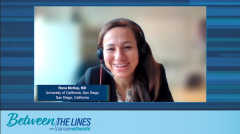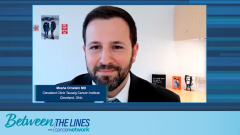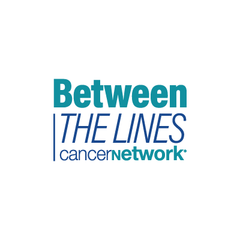
The Influence of Risk Category Stratification Algorithms on CLEAR Trial Data
Thomas Hutson, DO, PharmD, and Scott Tykodi, MD, PhD, discuss their takeaways from the CLEAR trial and how risk category stratification affected the study.
Episodes in this series

Thomas E. Hutson, DO, PharmD: Hi, my name is Tom Hutson. I am the director of the urologic oncology program for Texas Oncology, and the co-chair of the urologic oncology center research in treatment for Baylor Scott & White Health in Dallas, Texas. I'm a professor of medicine at Texas A&M University and Chair of GE Research for US Oncology McKesson. I'm joined by Scott Tykodi, and I'm going to ask him to introduce himself.
Scott Tykodi, MD, PhD: Thanks, Tom. Hi, I'm Scott Tykodi. I'm a medical oncologist and kidney cancer specialist, Associate Professor at the University of Washington and Fred Hutchinson Cancer Research Center in Seattle, Washington. I'm the clinical lead for our clinical trials program for kidney cancer patients.
Thomas E. Hutson, DO, PharmD: Excellent. Scott, we're asked to talk back and forth about our feelings of interpreting the latest combination regimen, the Lenvima [lenvatinib] and pembrolizumab [Keytruda] regimen that was published in New England Journal of Medicine, and so we're going to talk about our thoughts and how we incorporate this data into our practices. But I think the first thing is just from a global perspective, high level perspective, what are your key takeaways from that 2021 New England Journal publication? And are there any questions you think that remain answered?
Scott Tykodi, MD, PhD: That's pretty expansive, Tom. But I think one of the key elements for the CLEAR trial data was its entering into a field of frontline space that has several, very similar, competing regimens. I think if we think back to ipi/nivo [ipilimumab plus nivolumab], coming forward and being superior to sunitinib in the intermediate and poorest patients — that was practice changing, and it moved the field off of frontline TKI to IO regimens. And then we had IO/TKI doublets that came into the same space. So, this study enters into a crowded field, where I think the immediate question for me and for colleagues treating kidney cancer patients is, what does this look like in comparison to what I already have to work with? That's a tough ask; cross trial analyses and comparisons run the risk of being erroneous, and the follow up for all of these studies is fairly short. We don't have mature median survival values to make judgments on. So, on the one hand, it leaves a lot of grounds for debate and subjectivity. But it does, I think, make it challenging for folks to feel confident about what truly is the best. I think there are some areas that definitely influence the choice of the IO double regimen, or IO/TKI and the risk category subsets to patients. Tom, since you're an investigator on the study, you might be able to shed some light. Most of the frontline studies have come forward with risk category stratification by IMDC [The International Metastatic Renal Cell Carcinoma Database Consortium]. This study actually used the Memorial Sloan Kettering [Cancer Center] risk stratification. Was there a rationale to opt for the MSKCC algorithm, or was it just a time issue about when the study was actually designed? It's not a huge difference if you stratify or re-stratify by INDC. But I'm just curious if there's some thinking along those lines.
Thomas E. Hutson, DO, PharmD: Great observation, as I would expect from you, Scott. So, I think it was mainly just a timing issue. I think at the time that trial was being designed was few years before we got the results, obviously. And that was about the time when the INDC data was percolating, and this was a global international trial. I think just for convenience’s sake, in the enrollment in non-US areas, the MSKCC criteria was just used, and as you appropriately say, they're very similar. But that's a slight nuance. And I think you bring up the point, and I think it leads to the point that we don't know as a group of investigators, of how much difference between subgroups enrolled under trial actually influence the outcome of the trial. So, what I mean, when we go through and look at the percentage of patients that are in this theoretical, favorable, intermediate, and poor risk, we all know that has prognostic significance of quite a large amount. And you can sway results by potentially more of 1 characteristic than the other. Not all the trials have the same number of patients enrolled in them. Is that enough to explain some of the differences that we see? Nonetheless, we won't be able to answer that. But I think you would have to agree with me that at least on the surface, all things being the same that the numbers coming out, the efficacy, the so-called trifecta of response rate progression, free survival and overall survival, seem to favor this combination. Right?
Scott Tykodi, MD, PhD: Yeah, I think that's certainly one of the selling points for this study. I think that leads to sort of one of the clinical presentations where this resonates in our clinic, the patient that comes in with very bulky disease, and we really fear early progression is going to get them into deep water, and maybe end their therapy options. I think the very low incidence of primary refractory disease — 5% in this dataset — is very exciting. Then the high response rate in the very long PFS, that's quantitatively better than the competitors out there. So, I think, in just the last couple of weeks, I've had 2 or 3 patients in a row that came in with extremely large caliber tumor findings in the liver, younger patients that clinically felt well, but you could see the train coming. And if they didn't gain control of their disease, they're going to be in terrible trouble very, very quickly. So I selected this regimen for exactly those reasons of hoping for optimizing the chance for disease control, and maybe some cytoreduction of the patients right off the bat and get them going with therapy. I think that's certainly one of the strong suits of this regimen.
Transcript edited for clarity.
Newsletter
Stay up to date on recent advances in the multidisciplinary approach to cancer.




























































































